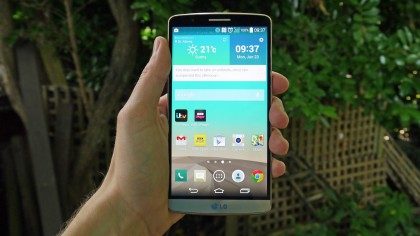4K phone screens: madness, or clearly the next big thing?
Screens are set to get crisper but it may be a needless tech advancement

In the last few years, as smartphone design has basically settled on rectangular slabs of glass, we've seen manufacturers take the competition over who produces the best gear to a new battle ground: the specs war.
Nowhere is this clearer and more easily visible than smartphone displays, the resolutions of which have been on a steadily upwards trend for the last couple of generations of flagship phones.
Historically, smartphone screens have got that little bit better every season. The HTC One X had a 720p HD screen; the Galaxy S4 and HTC One both stepped up to 1080p Full HD displays, and we're now seeing 2K displays pop up on the likes of the LG G3.
The trend would suggest, therefore, that 4K displays will be commonplace within the next two or so generations of flagship phone.
Does the world need more than the G3's QHD display?
To understand why a 4K screen on a phone might (or might not!) be a good idea, you first have to understand exactly what 4K means.
At a basic level, all screens have a resolution, which is expressed as the number of horizontal pixels times vertical pixels – for example, 1280 x 720, meaning that there's 1280 rows of pixels horizontally, and 720 vertically.
In theory, the higher the resolution, the crisper and less blurry the image. The resolution is often abbreviated to a snappier name – for example, the 'HD' logo that's slapped on most TVs these days. High Definition means a resolution of at least 720 pixels vertically, and 'Full HD' is a minimum of 1080.
Sign up for breaking news, reviews, opinion, top tech deals, and more.
However, there are several levels above mere 'HD'. 2K video has to be at least 2,000 pixels wide horizontally (Full HD (1080p) is generally 1980 pixels horizontally). QHD (Quad HD) has a horizontal resolution a little higher, at 2,560 pixels, meaning that there's four times as many actual pixels than in 1080p, hence Quad-HD.

But the gold standard of ultra hi-res is currently 4K, which offers a display resolution normally of 3840 x 2160.
It's a standard that's starting to creep into high-end TVs and computer monitors, and even more common services like YouTube and GoPro are starting to record or playback 4K footage.
iPhone 4: the original Retina display
The allure of higher-res screens is simple: more pixels should, in theory, mean a sharper, clearer, more detailed image – the effect Apple had with the iPhone 4 when it introduced the first 'Retina Screen'.
But improvement isn't just as simple as sticking a higher-res screen in each new generation of phone: after a while, people will stop noticing the difference.
This is because of one crucial factor: pixel density. This is a measure of how many pixels are packed into a physical area, normally measured in pixels per inch (PPI, not to be confused with the insurance you maybe owed money for, according to those irritating phone calls and adverts).

Because smartphone screens are so physically tiny compared to TVs, the PPI is incredibly high – up to 530 on phones like the LG G3.
Although that might sound like improvement, the human eye stops being able to make out a screen's individual pixels after a certain point – and after that point, increasing the resolution further won't really do anything of benefit.
According to Apple, that cut-off is 326 PPI for a smartphone. (Your eye's 'max' PPI depends on how far away the device is – hold press your face right up to a 4K TV, and you could probably see the individual pixels, but not so for a smartphone.)
Experts, such as DisplayMate's Raymond Soniera, peg that number a little higher – up to 600PPI for people with freakishly good vision.
But either way, whether the magic number is 300 PPI or 600 PPI, 4K blows all those numbers away. On a standard 4.7-inch smartphone screen, a 4K display would give a resolution of 941 PPI, well in excess of anyone's ability to resolve individual pixels. By that measure, 4K phone screens would be completely indistinguishable from 2K, or probably even Full HD screens.